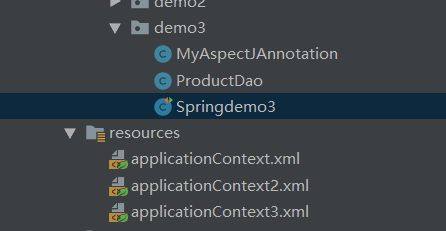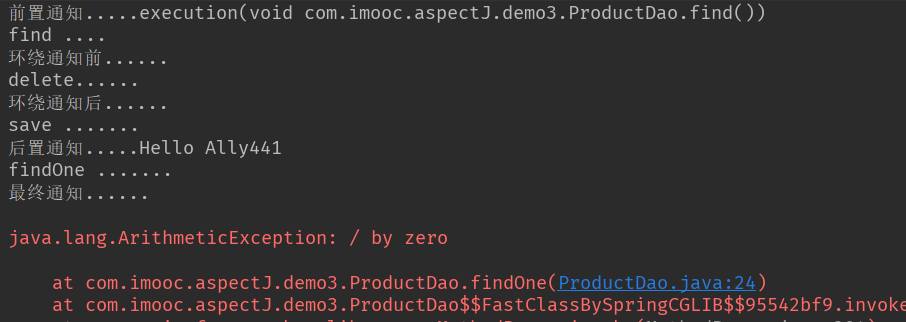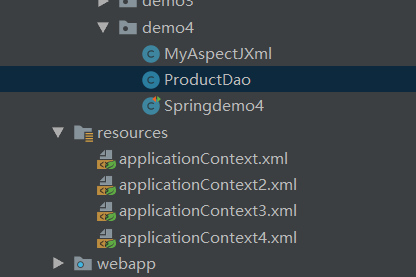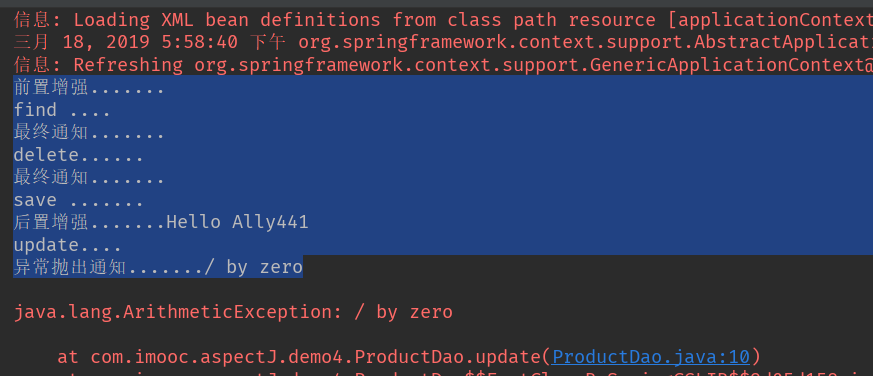Realize AOP development mode based on AspectJ:
- Annotation mode
- XML mode
AspectJ is an AOP framework based on Java language; support for AspectJ pointcut expressions has been added since spring 2.0
@AspectJ is a new function of AspectJ 1.5. With JDK 1.5 annotation technology, you can directly define facets in Bean classes
@AspectJ provides different notification types
- @Before notice, equivalent to BeforeAdvice
- @AfterReturning post notification, equivalent to AfterReturning advice
- @Around notification, equivalent to MethodInterceptor
- @After final notification, no matter whether it is abnormal or not, it will execute
- @The AfterThrowing exception throws a notification, which is equivalent to ThrowAdvice
- @DeclareParents referral notification, equivalent to introductioninterceptor
Implement the above notification by annotation
<!---applicationContext3.xml-->
<?xml version="1.0" encoding="UTF-8"?>
<beans xmlns="http://www.springframework.org/schema/beans"
xmlns:xsi="http://www.w3.org/2001/XMLSchema-instance"
xmlns:aop="http://www.springframework.org/schema/aop" xsi:schemaLocation="
http://www.springframework.org/schema/beans http://www.springframework.org/schema/beans/spring-beans.xsd
http://www.springframework.org/schema/aop http://www.springframework.org/schema/aop/spring-aop.xsd">
<!--open AspectJ Annotation development, auto agent-->
<aop:aspectj-autoproxy/>
<!--Target class-->
<bean id="productDao" class="com.imooc.aspectJ.demo3.ProductDao"/>
<!--section-->
<bean class="com.imooc.aspectJ.demo3.MyAspectJAnnotation"/>
</beans>
//ProductDao target class
package com.imooc.aspectJ.demo3;
public class ProductDao {
public void find(){
System.out.println("find ....");
}
public void update(){
System.out.println("update....");
int i =1/0;//Verify if an exception is thrown
}
public void delete(){
System.out.println("delete......");
}
public String save(){
System.out.println("save .......");
return "Hello Ally441";
}
public void findOne(){
System.out.println("findOne .......");
int i =1/0;//Verify that the final method to throw the exception executes
}
}
package com.imooc.aspectJ.demo3;
import org.aspectj.lang.JoinPoint;
import org.aspectj.lang.ProceedingJoinPoint;
import org.aspectj.lang.annotation.*;
/**
* Section class
*/
@Aspect
public class MyAspectJAnnotation {
@Before(value="pointcut1()")
public void Before(JoinPoint joinPoint){
System.out.println("Before advice....."+joinPoint);
}
@AfterReturning(value = "pointcut2()",returning = "result")
public void AfterReturning(Object result){
System.out.println("Post notification....."+result);
}
@Around(value = "pointcut3()")
public Object Around(ProceedingJoinPoint joinPoint) throws Throwable {
System.out.println("Before surround notification......");
Object object = joinPoint.proceed();
System.out.println("After surround notification......");
return object;
}
@AfterThrowing(value = "pointcut4()" ,throwing = "e")
public void AfterThrowing(Throwable e){
System.out.println("Exception throw notification....."+e.getMessage());
}
@After(value = "pointcut5()")
public void After(){
System.out.println("Final notice......");
}
//Pointcut is used to define the pointcut, because if the pointcut is defined in each notice, repeated pointcuts will cause heavy workload and difficult maintenance
@Pointcut(value = "execution(* com.imooc.aspectJ.demo3.ProductDao.find(..))")
public void pointcut1(){}
@Pointcut(value = "execution(* com.imooc.aspectJ.demo3.ProductDao.save(..))")
public void pointcut2(){}
@Pointcut(value = "execution(* com.imooc.aspectJ.demo3.ProductDao.delete(..))")
public void pointcut3(){}
@Pointcut(value = "execution(* com.imooc.aspectJ.demo3.ProductDao.update(..))")
public void pointcut4(){}
@Pointcut(value = "execution(* com.imooc.aspectJ.demo3.ProductDao.findOne(..))")
public void pointcut5(){}
}
//Implementation class
package com.imooc.aspectJ.demo3;
import org.junit.Test;
import org.junit.runner.RunWith;
import org.springframework.test.context.ContextConfiguration;
import org.springframework.test.context.junit4.SpringJUnit4ClassRunner;
import javax.annotation.Resource;
@RunWith(SpringJUnit4ClassRunner.class)
@ContextConfiguration("classpath:applicationContext3.xml")
public class Springdemo3 {
@Resource(name = "productDao")
private ProductDao productDao;
@Test
public void demo1(){
productDao.find();
productDao.delete();
productDao.save();
productDao.findOne();
productDao.update();
}
}
Operation result:
Implement the above notification in XML
<!--applicationContext4.xml-->
<?xml version="1.0" encoding="UTF-8"?>
<beans xmlns="http://www.springframework.org/schema/beans"
xmlns:xsi="http://www.w3.org/2001/XMLSchema-instance"
xmlns:aop="http://www.springframework.org/schema/aop" xsi:schemaLocation="
http://www.springframework.org/schema/beans http://www.springframework.org/schema/beans/spring-beans.xsd
http://www.springframework.org/schema/aop http://www.springframework.org/schema/aop/spring-aop.xsd">
<!--XML Configuration mode of AOP Development-->
<!--Configure target class-->
<bean id="customerDao" class="com.imooc.aspectJ.demo2.CustomerDaoImpl"/>
<!--Configure facet classes-->
<bean id="myAspectXml" class="com.imooc.aspectJ.demo2.MyAspectXml"/>
<!--aop Configuration-->
<aop:config>
<!--Define pointcuts: which classes and methods need to be enhanced-->
<aop:pointcut id="pointCut1" expression="execution(* com.imooc.aspectJ.demo2.CustomerDao.update(..))"/>
<aop:pointcut id="pointCut2" expression="execution(* com.imooc.aspectJ.demo2.CustomerDao.delete(..))"/>
<aop:pointcut id="pointCut3" expression="execution(* com.imooc.aspectJ.demo2.CustomerDao.save(..))"/>
<aop:pointcut id="pointCut4" expression="execution(* com.imooc.aspectJ.demo2.CustomerDao.findOne(..))"/>
<aop:pointcut id="pointCut5" expression="execution(* com.imooc.aspectJ.demo2.CustomerDao.findAll(..))"/>
<!--Configuration section-->
<aop:aspect ref="myAspectXml">
<aop:before method="before" pointcut-ref="pointCut1"/>
<aop:after-returning method="afterReturning" pointcut-ref="pointCut2" returning="object"/>
<aop:around method="around" pointcut-ref="pointCut3"/>
<aop:after-throwing method="afterThrowing" pointcut-ref="pointCut4" throwing="e"/>
<aop:after method="after" pointcut-ref="pointCut5"/>
</aop:aspect>
</aop:config>
</beans>
//Target class
package com.imooc.aspectJ.demo4;
public class ProductDao {
public void find(){
System.out.println("find ....");
}
public void update(){
System.out.println("update....");
int i =1/0;
}
public void delete(){
System.out.println("delete......");
}
public String save(){
System.out.println("save .......");
return "Hello Ally441";
}
public void findOne(){
System.out.println("findOne .......");
}
}
//Section class
package com.imooc.aspectJ.demo4;
import org.aspectj.lang.ProceedingJoinPoint;
public class MyAspectJXml {
public void before(){
System.out.println("Preamplifier.......");
}
public void afterReturning(Object object){
System.out.println("Post enhancement......."+object);
}
public Object Around(ProceedingJoinPoint joinPoint) throws Throwable {
System.out.println("Before surround enhancement.......");
Object object = joinPoint.proceed();
System.out.println("After surround enhancement.......");
return object;
}
public void afterThrowing(Throwable e){
System.out.println("Exception throw notification......."+e.getMessage());
}
public void after(){
System.out.println("Final notice.......");
}
}
//Test class
package com.imooc.aspectJ.demo4;
import org.junit.Test;
import org.junit.runner.RunWith;
import org.springframework.beans.factory.annotation.Autowired;
import org.springframework.test.context.ContextConfiguration;
import org.springframework.test.context.junit4.SpringJUnit4ClassRunner;
@RunWith(SpringJUnit4ClassRunner.class)
@ContextConfiguration("classpath:applicationContext4.xml")
public class Springdemo4 {
@Autowired
private ProductDao productDao;
@Test
public void demo1(){
productDao.find();
productDao.findOne();
productDao.delete();
productDao.save();
productDao.update();
}
}
Operation result